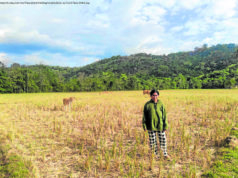The storm, which was a Category 1 hurricane, was expected to restrengthen later on Tuesday.
Hurricane Zeta, which brought torrential rains as it slammed into the Yucatán Peninsula of Mexico, was downgraded to a tropical storm on Tuesday morning. It offered further evidence that this hurricane season has not only been extremely active, but also extremely wet. Zeta, which late Monday hit the Yucatán’s northeastern coast as a Category 1 hurricane, is the 27th named storm of a season that is far from over: Storms could continue to form for another five weeks, and possibly longer. The season is one shy of the record set in 2005, when 28 storms grew strong enough to warrant names. According to a 8 a.m. Eastern time advisory from the National Hurricane Center, Zeta was located over the northern Yucatán Peninsula and was moving toward the northwest with winds around 70 miles per hour. The storm, the center said, was expected to turn north Tuesday night and move over the central Gulf of Mexico on Wednesday, making landfall along the northern Gulf States late Wednesday or Wednesday night. Zeta was forecast to restrengthen and become a hurricane again later on Tuesday. The storm may be at or near hurricane strength when it approaches the northern Gulf Coast late Wednesday. A hurricane warning was in affect Tuesday morning for Morgan City, La., to the Mississippi and Alabama border, including metropolitan New Orleans. Up to six inches of rain was expected across these areas and points north. If the forecasts hold, Zeta will continue a pattern that has been playing out this year where much of the damage from storms has come not from wind but from water. And that destructiveness is linked to climate change. Of the 27 named storms so far in 2020, only four have been major hurricanes, rated Category 3 or higher. (In 2005 there were seven major hurricanes, also a record.) Seventeen of 2020’s storms never got above tropical storm strength, with winds below 73 miles per hour, but heavy rains accompanied many of them, starting with Tropical Storm Bertha, which brought 14 inches of rain to parts of South Florida in late May. All tropical cyclones pick up moisture as they develop and travel across the ocean. But global warming has raised average air temperatures, and warmer air holds more moisture. Studies of specific storms, including Hurricane Harvey, which brought four feet or more of rain to the Houston area in August 2017, have found them to be affected by human-induced climate change.






